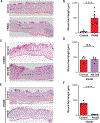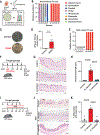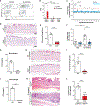Debaryomyces is enriched in Crohn's disease intestinal tissue and impairs healing in mice
- PMID: 33707263
- PMCID: PMC10114606
- DOI: 10.1126/science.abd0919
Debaryomyces is enriched in Crohn's disease intestinal tissue and impairs healing in mice
Abstract
Alterations of the mycobiota composition associated with Crohn's disease (CD) are challenging to link to defining elements of pathophysiology, such as poor injury repair. Using culture-dependent and -independent methods, we discovered that Debaryomyces hansenii preferentially localized to and was abundant within incompletely healed intestinal wounds of mice and inflamed mucosal tissues of CD human subjects. D. hansenii cultures from injured mice and inflamed CD tissues impaired colonic healing when introduced into injured conventionally raised or gnotobiotic mice. We reisolated D. hansenii from injured areas of these mice, fulfilling Koch's postulates. Mechanistically, D. hansenii impaired mucosal healing through the myeloid cell-specific type 1 interferon-CCL5 axis. Taken together, we have identified a fungus that inhabits inflamed CD tissue and can lead to dysregulated mucosal healing.
Copyright © 2021 The Authors, some rights reserved; exclusive licensee American Association for the Advancement of Science. No claim to original U.S. Government Works.
Conflict of interest statement
Figures




Comment in
-
Fungi prevent intestinal healing.Science. 2021 Mar 12;371(6534):1102-1103. doi: 10.1126/science.abg6017. Science. 2021. PMID: 33707253 No abstract available.
-
Fungi in Crohn's disease and mucosal healing.Nat Rev Gastroenterol Hepatol. 2021 May;18(5):285. doi: 10.1038/s41575-021-00451-3. Nat Rev Gastroenterol Hepatol. 2021. PMID: 33846601 No abstract available.
-
Debaryomyces, the Achilles heel of wound repair.Cell Host Microbe. 2021 May 12;29(5):740-741. doi: 10.1016/j.chom.2021.04.013. Cell Host Microbe. 2021. PMID: 33984275 Free PMC article.
Similar articles
-
Fungus fuels mucosal wounds in Crohn's disease.Immunity. 2021 May 11;54(5):856-858. doi: 10.1016/j.immuni.2021.04.013. Immunity. 2021. PMID: 33979584
-
Inflammation-related differences in mucosa-associated microbiota and intestinal barrier function in colonic Crohn's disease.Am J Physiol Gastrointest Liver Physiol. 2018 Sep 1;315(3):G420-G431. doi: 10.1152/ajpgi.00411.2017. Epub 2018 May 31. Am J Physiol Gastrointest Liver Physiol. 2018. PMID: 29848021
-
Succinate Produced by Intestinal Microbes Promotes Specification of Tuft Cells to Suppress Ileal Inflammation.Gastroenterology. 2020 Dec;159(6):2101-2115.e5. doi: 10.1053/j.gastro.2020.08.029. Epub 2020 Aug 21. Gastroenterology. 2020. PMID: 32828819 Free PMC article.
-
Development, validation and implementation of an in vitro model for the study of metabolic and immune function in normal and inflamed human colonic epithelium.Dan Med J. 2015 Jan;62(1):B4973. Dan Med J. 2015. PMID: 25557335 Review.
-
A new look at Crohn's disease: breakdown of the mucosal antibacterial defense.Ann N Y Acad Sci. 2006 Aug;1072:321-31. doi: 10.1196/annals.1326.030. Ann N Y Acad Sci. 2006. PMID: 17057212 Review.
Cited by
-
Host-pathobiont interactions in Crohn's disease.Nat Rev Gastroenterol Hepatol. 2024 Oct 24. doi: 10.1038/s41575-024-00997-y. Online ahead of print. Nat Rev Gastroenterol Hepatol. 2024. PMID: 39448837 Review.
-
Unveiling the overlooked fungi: the vital of gut fungi in inflammatory bowel disease and colorectal cancer.Gut Pathog. 2024 Oct 15;16(1):59. doi: 10.1186/s13099-024-00651-7. Gut Pathog. 2024. PMID: 39407244 Free PMC article. Review.
-
The Role of Fecal Microbiota Transplantation in IBD.Microorganisms. 2024 Aug 23;12(9):1755. doi: 10.3390/microorganisms12091755. Microorganisms. 2024. PMID: 39338430 Free PMC article. Review.
-
Editorial: The intricate web of gastrointestinal virome, mycome and archaeome: implications for gastrointestinal diseases.Front Genet. 2024 Aug 9;15:1463350. doi: 10.3389/fgene.2024.1463350. eCollection 2024. Front Genet. 2024. PMID: 39184347 Free PMC article. No abstract available.
-
The gut mycobiome signatures in long-lived populations.iScience. 2024 Jun 28;27(8):110412. doi: 10.1016/j.isci.2024.110412. eCollection 2024 Aug 16. iScience. 2024. PMID: 39081291 Free PMC article.
References
Publication types
MeSH terms
Substances
Grants and funding
LinkOut - more resources
Full Text Sources
Other Literature Sources
Medical

